Environment Degradation, Health Threats, and Legality at the Artisanal Small-Scale Gold Mining Sites in Indonesia
Abstract
1. Introduction
2. Materials and Methods
3. Results
3.1. Legality/Illegality Aspects of Gold Mining in Indonesia
3.1.1. Legal Mining
3.1.2. Illegality of ASGM and Environmental Problems
3.2. Environmental Degradation of Several Gold Mining Locations
3.2.1. Suwawa Timur District, Bone Bolango Regency, Gorontalo Province
3.2.2. Pesawaran Regency, Lampung Province
| Location | Year (Sampling) | Sample Type | Mercury Concentration | Guidelines | Ref. |
|---|---|---|---|---|---|
| Pesawaran Regency | 2020 | Soil | 0.26–28.9 mg/L | 0.005 mg/L Indonesian Government Regulation No. 82 year 2001 | [52] (data from the same project team) |
| River water | 0.08–14.1 mg/L | 0.005 mg/L Indonesian Government Regulation No. 82 year 2001 | |||
| Pesawaran Regency | 2022 | Fruit tree bark Tamarindus indica, Persea americana, Annona muricata | 0.82 mg/g, 0.41 mg/g, 0.58 mg/g | 0.03 ppm Hg threshold | [49] (data from the same project team) |
| Pesawaran Regency | 2022 | Tree bark Magnolia champaca, Swietenia mahagoni, Pterospermum acerifolium | 1.01 µg/g, 0.38 µg/g, 0.37µg/g | Exceed 10 ppm: Hyperaccumulators of Hg, 1 ppm: Toxic and does not exceed 0.5 mg/kg Director General of National Agency of Drug and Food Control No: 03725/B/SK/VII/89 | [50] (data from the same project team) |
3.2.3. Cigaru, Kertajaya Village, Simpenan Sub-District, Sukabumi Regency, West Java Province
4. Discussion
4.1. Lesson Learned from Three Locations of Illegal ASGM
4.2. Complexity of Legality/Illegality and Governmental Actions for Transforming ASGM
4.3. Suggestions
5. Conclusions
Author Contributions
Funding
Institutional Review Board Statement
Informed Consent Statement
Data Availability Statement
Acknowledgments
Conflicts of Interest
References
- Soe, P.S.; Kyaw, W.T.; Arizono, K.; Ishibashi, Y.; Agusa, T. Mercury pollution from artisanal and small-scale gold mining in Myanmar and other Southeast Asian countries. Int. J. Environ. Res. Public Health 2022, 19, 6290. [Google Scholar] [CrossRef]
- Murao, S.; Tomiyasu, K.; Ono, K.; Shibata, H.; Narisawa, N.; Takenaka, C. Mercury distribution in artisanal and small-scale gold mining area: A case study of hot spots in Camarines Norte, Philippines. Int. J. Environ. Sci. Dev. 2019, 10, 122–129. [Google Scholar] [CrossRef][Green Version]
- Tun, A.Z.; Wongsasuluk, P.; Siriwong, W. Heavy Metals in the soils of placer small-scale gold mining sites in Myanmar. J. Health Pollut. 2020, 10, 200911. [Google Scholar] [CrossRef]
- Kawakami, T.; Konishi, M.; Imai, Y.; Soe, P.S. Diffusion of mercury from artisanal small-scale gold mining (ASGM) sites in Myanmar. Geomate J. 2018, 17, 228–235. Available online: https://geomatejournal.com/geomate/article/view/2180. (accessed on 31 July 2023). [CrossRef]
- Caballero-Gallardo, K.; Palomares-Bolaños, J.; Olivero-Verbel, J. Mercury Concentrations in Water, Sediments, Soil, and Fish Around Ancestral Afro-Descendant Territories Impacted by Gold Mining in the Cauca Department, Colombia. Water Air Soil Pollut. 2022, 233, 393. [Google Scholar] [CrossRef]
- Mambrey, V.; Rakete, S.; Tobollik, M.; Shoko, D.; Moyo, D.; Schutzmeier, P.; Steckling-Muschack, N.; Muteti-Fana, S.; Bose-O’Reilly, S. Artisanal and small-scale gold mining: A cross-sectional assessment of occupational mercury exposure and exposure risk factors in Kadoma and Shurugwi, Zimbabwe. Environ. Res. 2020, 184, 109379. [Google Scholar] [CrossRef] [PubMed]
- Calao-Ramos, C.; Bravo, A.G.; Paternina-Uribe, R.; Marrugo-Negrete, J.; Díez, S. Occupational human exposure to mercury in artisanal small-scale gold mining communities of Colombia. Environ. Int. 2021, 146, 106216. [Google Scholar] [CrossRef]
- Tampushi, L.L.; Onyari, J.M.; Muthama, N.J. Assessing Social and Environmental Impacts of Artisanal and Small-Scale Gold Mining Practices in Lolgorian, Kenya. Eur. J. Sustain. Dev. Res. 2022, 6, em0192. [Google Scholar] [CrossRef]
- Salim, H. Hukum Pertambangan di Indonesia; PT. Raja Grafindo Persada: Jakarta, Indonesia, 2014. [Google Scholar]
- Bachriadi, D. Contentious Forestland: Large-scale vs Small-scale Gold Mining and the Questions of Sustainability. In Proceedings of the XIX Biennial IASC Conference, Nairobi, Kenya, 19–24 June 2023. [Google Scholar]
- Bachriadi, D.; Abbas, T. Political-economy of Mercury-free: A Perspective from ASGM Practice. In Proceedings of the 2023 NERP Conference, Asian Institute of Technology, Bangkok, Thailand, 28 February–3 March 2023. [Google Scholar]
- Peluso, N.L. Entangled Territories in Small-scale Gold Mining Frontiers: Labor Practice, Property, and Secrets in Indonesian Gold Country. World Dev. 2018, 101, 400–416. [Google Scholar] [CrossRef]
- Suli, U.W. Control of Illegal Mining (PETI) in Indonesia: Policy and Program. Indones. Min. J. 2011, 14, 1. [Google Scholar]
- Rahim, S. Konflik Pemanfaatan Ruang Akibat Penambangan Emas Tanpa Ijin (PETI) di Kawasan Hutan Produksi Terbatas. J. GeoEco. 2017, 3, 17–25. [Google Scholar]
- Arifin, Y.; Sakakibara, M.; Sera, K. Impacts of Artisanal and Small-Scale Gold Mining (ASGM) on Environment and Human Health of Gorontalo Utara Regency, Gorontalo Province, Indonesia. Geosciences 2015, 5, 160–176. [Google Scholar] [CrossRef]
- Wibowo, Y.G.; Ramadan, B.S.; Maryani, A.T.; Rosarina, D.; Arkham, L.O. Impact of Illegal Gold Mining in Jambi, Indonesia. Indones. Min. J. 2022, 25, 29–40. [Google Scholar] [CrossRef]
- Hruschka, F. Countries—ASM Status, ASM Miners and ASM Commodities Mined. 2023. Available online: http://artisanalmining.org/InventoryData/doku.php/country:country?do= (accessed on 10 June 2023).
- Meutia, A.A.; Lumowa, R.; Sakakibara, M. Indonesian Artisanal and Small-Scale Gold Mining—A Narrative Literature Review. Int. J. Environ. Res. Public Health 2022, 19, 3955. [Google Scholar] [CrossRef]
- Mestanza-Ramon, C.; Mora-Silva, D.; D’Orio, G.; Tapia-Segarra, E.; Gaibor, I.D.; Parra, J.F.E.; Velasquez, C.R.C.; Straface, S. Artisanal and Small-Scale Gold Mining (ASGM): Management and Socioenvironmental Impacts in the Northern Amazon and Ecuador. Sustainability 2022, 14, 6854. [Google Scholar] [CrossRef]
- Macdonald, F.K.F.; Kund, M.; Blanchette, M.; McCulloch, C. Regulation of Artisanal Small Scale Gold Mining (ASGM) in Ghana and Indonesia as Currently Implemented Fails to Adequately Protect Aquatic Ecosystems. In An Interdisciplinary Response to Mine Water Challenges: The Proceedings of the 12th IMWA Congress; Siu, W., Sun, Y., Wang, C., Eds.; China University of Mining and Technology Press: Xuzhou, China, 2014; pp. 401–405. [Google Scholar]
- Lihawe, F.; Mahmud, M. The content of mercury in sediments around Artisanal Small-scale Gold Mining (ASGM) Bumela district, Gorontalo Regency, Gorontalo Province, Indonesia. IOP Conf. Ser. Earth Environ. Sci. 2019, 314, 012016. [Google Scholar] [CrossRef]
- Massaro, L.; Calvimontes, J.; Ferreira, L.C.; de Theije, M. Balancing economic development and environmental responsibility: Perception from communities of garimpeiros in the Brazilian Amazon. Resour. Policy 2022, 79, 103063. [Google Scholar] [CrossRef]
- Marshall, B.G.; Veiga, M.M. Formalization of artisanal miners: Stop the train, we need to get off. Extr. Ind. Soc. 2017, 4, 300–303. [Google Scholar] [CrossRef]
- Trimiska, L.; Wiryono, W.; Suhartoyo, H. Kajian Penambangan Emas Tanpa Izin (Peti) Di Kecamatan Lebong Utara Kabupaten Lebong. J. Unib. 2017, 7, 1–9. [Google Scholar] [CrossRef]
- Edinger, E. Gold Mining and Submarine Tailings Disposal: Review and Case Study. Oceanography 2012, 25, 184–199. Available online: http://www.jstor.org/stable/24861356 (accessed on 20 June 2023). [CrossRef]
- Hilson, G. Small-Scale Mining in Africa: Tackling Pressing Environmental Problems with Improved Strategy. J. Environ. Dev. 2002, 11, 149–174. [Google Scholar] [CrossRef]
- Gafur, N.A.; Sakakibara, M.; Sano, S.; Sera, K. A Case Study of Heavy Metal Pollution in Water of Bone River by Artisanal Small-Scale Gold Mine Activities in Eastern Part of Gorontalo, Indonesia. Water 2018, 10, 1507. [Google Scholar] [CrossRef]
- Steckling, N.; Tobollik, M.; Plass, D.; Hornberg, C.; Ericson, B.; Fuller, R.; Bose-O’Reilly, S. Global Burden of Disease of Mercury Used in Artisanal Small-Scale Gold Mining. Ann. Glob. Health 2017, 83, 234–247. [Google Scholar] [CrossRef] [PubMed]
- Singga, S. Health Risk Assessment of Mercury Exposure in the Bulawa District Community, Bone Bolango Regency, Gorontalo Province. J. MKMI 2013, 9, 21–28. [Google Scholar] [CrossRef]
- Arifin, Y.I.; Sakakibara, M.; Takakura, S.; Jahja, M.; Lihawa, F.; Sera, K. Artisanal and Small-Scale Gold Mining Activities and Mercury Exposure in Gorontalo Utara Regency, Indonesia. Toxicol. Environ. Chem. 2020, 102, 521–542. [Google Scholar]
- Rianto, S.; Setiani, O.; Budiyono, B. Analysis of Factors Associated with Mercury Poisoning of The Traditional Gold Miner at Jendi Village, Selogiri Subdistrict, Wonogiri District. J. Kesehat. Lingkung. Indones. 2012, 11, 1. Available online: https://www.neliti.com/publications/4783/analisis-faktor-faktor-yang-berhubungan-dengan-keracunan-merkuri-pada-penambang (accessed on 20 June 2023).
- Jiskani, I.M.; Cai, Q.; Zhou, W.; Lu, X.; Shah, S.A.A. An integrated fuzzy decision support system for analyzing challenges and pathways to promote green and climate smart mining. Expert Syst. Appl. 2022, 188, 116062. [Google Scholar] [CrossRef]
- Spiegel, S.J.; Agrawal, S.; Mikha, D.; Vitamerry, K.; Billon, P.L.; Veiga, M.; Konolius, K.; Paul, B. Phasing Out Mercury: Ecological Economics and Indonesia’s Small-Scale Gold Mining Sector. Ecol. Econ. 2018, 14, 1–11. [Google Scholar] [CrossRef]
- Robles, M.E.; Verbrugge, B.; Geenen, S. Does formalization make a difference in artisanal and small-scale gold mining (ASGM)? Insights from the Philippines. Extr. Ind. Soc. 2022, 10, 101078. [Google Scholar] [CrossRef]
- Veiga, M.; Marshall, B.G. The Columbian artisanal mining sector: Formalization is a heavy burden. Extr. Ind. Soc. 2019, 6, 223–228. [Google Scholar] [CrossRef]
- Siddharta, A. Illegal Mining Endangers Lives, Environment in Indonesia. 2019. Available online: https://www.voanews.com/a/illegal-mining-endangers-lives-environment-in-indonesia/4828567.html (accessed on 26 June 2023).
- Gunawan, A. Illegal Mining Causing Over Rp. 80 t in Losses. The Jakarta Post, 5 May 2015. Available online: https://www.thejakartapost.com/news/2015/05/05/illegal-mining-causing-over-rp-80t-losses.html (accessed on 26 June 2023).
- Umar, R.H.U.; Rahim, S.; Mahmud, N. Kegiatan Pertambangan Rakyat Kabupaten Bone Bolango: Dampak Sosial Ekonomi dan Lingkungan. JiKTI 2015, 1–7. [Google Scholar]
- Eduful, M.; Asharif, K.; Eduful, A.; Acheampong, M.; Eduful, J.; Mazumder, L. The Illegal Artisanal and Small-Scale Mining (Galamsey) ‘Menace’ in Ghana: Is Military-Style Approach the Answer? Resour. Policy 2020, 68, 101732. [Google Scholar] [CrossRef]
- Pertiwi, M.D.; Setiadi, E. Penegakan Hukum Praktek Illegal Mining. J. Pros. Ilmu Huk. 2019, 5, 134. [Google Scholar]
- Direktorat Jenderal Mineral dan Batubara. Grand Strategy Mineral dan Batubara: Arah Pengembangan Hulu Hilir Mineral Utama dan Batubara Menuju Indonesia Maju; Direktorat Jenderal Mineral dan Batubara Kementerian Energi dan Sumber Daya Mineral: Jakarta, Indonesia, 2021. [Google Scholar]
- Gafur, N.A.; Sakakibara, M.; Komatsu, S.; Sano, S.; Sera, K. Environmental survey of the distribution and metal contents of Pteris vittata in arsenic–lead–mercury-contaminated gold mining areas along the Bone River in Gorontalo Province, Indonesia. Int. J. Environ. Res. Public Health 2022, 19, 530. [Google Scholar] [CrossRef] [PubMed]
- Pateda, S.M.; Sakakibara, M.; Sera, K. Element Rich Area Associated with Human Health Disorders: A Geomedical Science Approach to Potentially Toxic Elements Contamination. Int. J. Environ. Res. Public Health 2021, 18, 12202. [Google Scholar] [CrossRef]
- Basir, S.; Kimijima, M.; Sakakibara, M.; Pateda, S.M.; Sera, K. Contamination Level in Geo-Accumulation Index of River Sediments at Artisanal and Small-Scale Gold Mining Area in Gorontalo Province, Indonesia. Int. J. Environ. Res. Public Health 2022, 19, 6094. [Google Scholar] [CrossRef] [PubMed]
- Pateda, S.M.; Sakakibara, M.; Sera, K. Lung Function Assessment as an Early Biomonitor of Mercury-Induced Health Disorders in Artisanal and Small-Scale Gold Mining Areas in Indonesia. Int. J. Environ. Res. Public Health 2018, 15, 2480. [Google Scholar] [CrossRef] [PubMed]
- Mahmud, M. Spatial Temporal Spreading Model of Mercury Concentration as a Result of Traditional Gold Mining as a Basic of Pollution Monitoring and Evaluation in Tulabolo River’s Ecosystem Gorontalo Province. Ph.D. Thesis, Program Pascasarjana Fakultas Geografi, Universitas Gajah Mada, Yogyakarta, Indonesia, 2012. [Google Scholar]
- Lahay, S. Warga Resah Operasi Perusahaan Tambang Emas di Bone Bolango. Mongabay Situs Berita Lingkungan. 2021. Available online: https://www.mongabay.co.id/2021/09/30/warga-resah-operasi-perusahaan-tambang-emas-di-bone-bolango/ (accessed on 20 June 2023).
- Nuraini, S.F.; Abdullah, S. Keanekaragaman Burung di Taman Nasional Bogani Nani Wartabone; Balai TN Bogani Nani Wartabone: Kotamobagu, Indonesia, 2018. [Google Scholar]
- Rendra, T.; Riniarti, M.; Yuwono, S.B.; Prasetia, H.; Widiastuti, E.L.; Bakri, S.; Taufiq, A. Mapping Atmospheric Mercury in Lampung Province, Indonesia Using Bark of Multipurpose Tree Species. Atmosphere 2022, 13, 2. [Google Scholar] [CrossRef]
- Taufiq, A.; Riniarti, M.; Widiastuti, E.L.; Prasetia, H.; Yuwono, S.B.; Asmarahman, C.; Rendra, T. Atmospheric Hg Levels in Tree Barks Due to Artisanal Small-Scale Gold Mining Activity in Bunut Seberang Village in Indonesia. Atmosphere 2022, 13, 633. [Google Scholar] [CrossRef]
- Prasetia, H.; Sakakibara, M.; Omori, K.; Laird, J.S.; Sera, K.; Kurniawan, I.A. Mangifera Indica as Bioindicator of Mercury Atmospheric Contamination in an ASGM Area in North Gorontalo Regency, Indonesia. Geosciences 2018, 8, 31. [Google Scholar] [CrossRef]
- Yuwono, S.B.; Banuwa, I.S.; Suryono, S.R.; Somura, H.; Dermiyati. Mercury pollution in the soil and river water of the Ratai watershed by artisanal and small-scale gold mining activities in Pesawaran District, lampung, Indonesia. J. Degrad. Min. Lands Manag. 2023, 10, 4233–4243. [Google Scholar] [CrossRef]
- Aprilla, N. Analisis Curahan Waktu Kerja Wanita pada Daerah Tambang Emas di Desa Bunut Seberang dan Gunung Rejo Kecamatan Way Ratai Kabupaten Pesawaran Provinsi Lampung; Jurusan Agribisnis, Fakultas Pertanian, Universitas Lampung: Bandar Lampung City, Indonesia, 2022. [Google Scholar]
- Wijaya, T.; Supardi, A. Kemitraan Konservasi—Skema Pengelolaan Hatura Wan Abdul Rachman yang Dinanti. Mongabay Situs Berita Lingkungan. 2020. Available online: https://www.mongabay.co.id/2020/08/22/kemitraan-konservasi-skema-pengelolaan-tahura-wan-abdul-rachman-yang-dinanti/ (accessed on 20 June 2023).
- Harianja, A.H.; Syofyan, Y.; Saragih, G.S.; Tapriziah, E.R.; Masitoh, S. Pencemaran merkuri di Kabupaten Sukabumi. Progress Report; Pusat Penelitian dan Pengembangan Kualitas dan Laboratorium Lingkungan Badan Litbang dan Inovasi: Serpong, Indonesia, 2018. [Google Scholar]
- Harianja, A.H.; Saragih, G.S.; Fauzi, R.; Hidayat, M.Y.; Syofyan, Y.; Tapriziah, E.R.; Kartiningsih, S.E. Mercury exposure in artisanal and small-scale gold mining communities in Sukabumi, Indonesia. J. Health Pollut. 2020, 10, 201209. [Google Scholar] [CrossRef]
- Nuryanty, C.D.; Riani, E.; Abidin, Z.; Sutjahjo, S.H.; Riyadi, A. Predictive modelling of mercury pollution in Indonesian ASGM areas and evaluation of the main factors using machine learning algorithm. IOP Conf. Ser. Earth Environ. Sci. 2022, 1109, 012046. [Google Scholar] [CrossRef]
- Pemkab Sukabumi Larang Eksploitasi Tambang Emas Cigaru. Bisnis.com, 13 May 2011. Available online: https/bandung.bisnis.com/read/20110513/549/946348/pemkab-sukabumi-larang-eksploitasi-tambang-emas-cigaru (accessed on 14 June 2023).
- Kristianingsih, Y. Bahaya merkuri pada masyarakat di pertambangan emas skala kecil (PESK) Lebaksitu. J. Ilm. Kesehat. 2018, 10, 32–38 (accessed on 1 August 2023). [Google Scholar] [CrossRef]
- Agung, L.N.; Hutamadi, R. Exposure of mercury at Cisoka local people gold mining area in Lebak Regency, Banten: A review of medical geology. Bul. Sumber Daya Geol. 2012, 7, 133–146. [Google Scholar] [CrossRef]
- Bose-O’Reilly, S.; Schierl, R.; Nowak, D.; Siebert, U.; William, J.F.; Owi, F.T.; Ismawati, Y. A preliminary study on health effects in villagers exposed to mercury in a small-scale artisanal gold mining area in Indonesia. Environ. Res. 2016, 149, 274–281. [Google Scholar] [CrossRef]
- Munawar, A.; Suhartoyo, H.; Asriani, P.S. Mercury toxicity potential from artisanal and small-scale gold mines in Lebong Regency, Bengkulu Province. E3S Web Conf. 2018, 73, 06002. [Google Scholar]
- Munawar, A.; Intania, C.; Barchia, M.F.; Suhartoyo, H.; Asriani, P.S. Mercury pollution form small scale gold mines in agricultural lands. IOP Conf. Ser. Earth Environ. Sci. 2022, 1018, 012021. [Google Scholar] [CrossRef]
- Mulyadi, I.; Zaman, B.; Sumiyati, S. Mercury (Hg) concentration of river water and sediment in Tambang Swah village due to gold mining without permission. E3S Web Conf. 2020, 202, 05021. [Google Scholar] [CrossRef]
- Hidayati, K. Distribusi logam berat pada air dan sedimen serta potensi bioakumulasi pada ikan akibat penambangan emas tanpa izin (studi kasus: DAS Sekoyor, Kalimantan Tengah). Media Ilm. Tek. Lingkung. 2019, 4, 24–33. [Google Scholar] [CrossRef]
- Ekawanti, A.; Krisnayanti, B.D. Effect of mercury exposure on renal function and hematological parameters among artisanal and small-scale gold miners at Sekotong, West Lombok, Indonesia. J. Health Pollut. 2015, 5, 25–32. [Google Scholar] [CrossRef] [PubMed]
- Ekawanti, A.; Priyambodo, S.; Kadriyan, H.; Syamsun, A.; Lestarini, I.A.; Wirasaka, G.; Ardianti, A.R. Mercury pollution in water and its effect on renal function of school age children in gold mining area Sekotong, West Lombok. IOP Conf. Ser. Earth Environ. Sci. 2021, 637, 012055. [Google Scholar] [CrossRef]
- Krisnayanti, B.D.; Anderson, C.W.N.; Utomo, W.H.; Feng, X.; Handayanto, E.; Mudarisna, N.; Ikram, H.; Khususiah. Assessment of environmental mercury discharge at a four-year-old artisanal gold mining area on Lombok Island, Indonesia. J. Environ. Monit. 2012, 14, 2598–2607. [Google Scholar] [CrossRef]
- Reichelt-Brushett, A.J.; Thomas, B.; Howe, P.L.; Male, Y.; Clark, M.W. Characterisation of artisanal mine waste on Buru Island, Indonesia, and toxicity to the brittle star Amphipholis squamata. Chemosphere 2017, 189, 171–179. [Google Scholar] [CrossRef]
- Mariwy, A.; Male, Y.T.; Manuhutu, J.B. Mercury (Hg) contents analysis in sediments at Some River estuaries in Kayeli Bay Buru Island. IOP Conf. Ser. Mater. Sci. Eng. 2019, 546, 022012. [Google Scholar] [CrossRef]
- Male, Y.T.; Reichelt-Brushett, A.J.; Pocock, M.; Nanlohy, A. Recent mercury contamination from artisanal gold mining on Buru Island, Indonesia—Potential future risks to environmental health and food safety. Mar. Pollut. Bull. 2013, 77, 428–433. [Google Scholar] [CrossRef]
- Reichelt-Brushett, A.J.; Stone, J.; Howe, P.L.; Thomas, B.; Clark, M.; Male, Y.; Nanlohy, A.; Butcher, P. Geochemistry and mercury contamination in receiving environments of artisanal mining wastes and identified concerns for food safety. Environ. Res. 2017, 152, 407–418. [Google Scholar] [CrossRef]
- Rumatoras, H.; Taipabu, M.I.; Lesiela, L.; Male, Y.T. Analysis of Mercury (Hg) Content on Hair Villagers Kayeli, Ilegal Gold Mining Result in Botak Mountain Area, Buru Regency-Maluku Province. Ind. J. Chem. Res. 2016, 3, 290–294. [Google Scholar]
- Simbolon, D.; Simange, S.M.; Wulandari, S.Y. Kandungan Merkuri dan Sianida pada Ikan yang Tertangkap dari Teluk Kao, Halmahera Utara. ILMU KELAUTAN Indones. J. Mar. Sci. 2010, 15, 126–134. [Google Scholar] [CrossRef]
- Bernadus, G.E.; Polii, B.; Rorong, J.A. Impact of mercury on the water environment around the mining liaction in Loloda District, West Halmahera District, North Maluku Province. Agri-Sosioekonomi 2021, 17, 599–610. [Google Scholar] [CrossRef]
- Hatika, R.G.; Dewata, I.; Iswadi, U.; Subekti, P.; Anwar, S. Illegal gold mining in Kuantan River: Mercury Contamination Analysis. IOP Conf. Ser. Earth Environ. Sci. 2020, 469, 012005. [Google Scholar] [CrossRef]
- Rosmiati, K.; Silvia, D. Analysis of Mercury (Hg) levels in mining workers hair of illegal gold mining in Kuansing District. J. Kesehat. Saelmakers PERDANA 2021, 4, 398–402. [Google Scholar]
- Yulis, P.A.R. Analisis kadar logam merkuri (Hg) dan (pH) air Sungai Kuantan terdampak penambangan emas tanpa izin (PETI). J. Pendidik. Kim. 2018, 2, 28–36. [Google Scholar] [CrossRef]
- Hasibuan, D.K.A.; Riani, E.; Anwar, S. Mercury (Hg) contamination in river water, well water, sediment and fish in Kuantan River, Riau. J. Nat. Resour. Environ. Manag. 2020, 10, 679–687. [Google Scholar]
- Sofia, S.; Husodo, A.H. Mercury contamination in the environmental samples and risk factors in inhabitants of the small-scale gold mining activities Krueng Sabee Aceh Province. J. Manusia Lingkungan 2016, 23, 310–318. [Google Scholar] [CrossRef][Green Version]
- Wahidah, S.; Khairi; Lelifajri; Idroes, R.; Rahmadi; Lala, A.; Mahmudi; Muslem; Japnur, A.F. Analysis of mercury and its distribution patterns in water and sediment samples from Krueng Sabee, Panga and Teunom rivers in Aceh Jaya. IOP Conf. Ser. Earth Environ. Sci. 2019, 364, 012016. [Google Scholar] [CrossRef]
- Indah, M.F.; Agustina, N.; Ariyanto, E. Analysis of mercury levels, degree of acidity and health risk factors for unlicensed gold miners in cempaka sub-district. Bul. Penelit. Kesehat. 2020, 48, 281–290. [Google Scholar] [CrossRef]
- Mirdat, Y.S.; Patadungan; Isrun. The level of heavy metal of mercury (Hg) in soil of agricultural area around gold mining in Poboya, Palu. e-J Agrotekbis 2013, 1, 127–134. [Google Scholar]
- Alhabsyi, G.A.P.; Putri, N.S.; Zulkifli, K.K.M.; Suherwin. An analysisi of gold ore mining impact on water pollution in Poboya, Central Sulawesi. J. Agribisnis Perikan. 2021, 14, 585–591. [Google Scholar]
- Polii, B.J.; Sonya, D.N. Pendugaan Kandungan Merkuri dan Sianida di daerah aliran sungai (DAS) Buyat Minahasa. EKOTON 2002, 2, 31–37. [Google Scholar]
- Basri; Sakakibara, M.; Sera, K.; Kurniawan, I.A. Mercury Contamination of Cattle in Artisanal and Small-Scale Gold Mining in Bombana, Southeast Sulawesi, Indonesia. Geosciences 2017, 7, 133. [Google Scholar] [CrossRef]
- Deveci, M.; Varouchakis, E.A.; Brito-Parada, P.R.; Mishra, A.R.; Rani, P.; Bolgkoranou, M.; Galetakis, M. Evaluation of risks impeding sustainable mining using fermatean fuzzy score function based SWARA method. Appl. Soft. Comput. 2023, 139, 110220. [Google Scholar] [CrossRef]
- Jiskani, I.M.; Moreno-Cabezali, B.M.; Rehman, A.U.; Fernandez-Crehuet, J.M.; Uddin, S. Implications to secure mineral supply for clean energy technologies for developing countries: A fuzzy based risk analysis for mining projects. J. Clean. Prod. 2022, 358, 132055. [Google Scholar] [CrossRef]
- Hilson, G. Barriers to Implementing Cleaner Technologies and Cleaner Production (CP) Practices in the Mining Industry: A Case Study of the Americas. Miner. Eng. 2000, 13, 699–717. [Google Scholar] [CrossRef]
- Hilson, G. Can microcredit services alleviate hardship in African small-scale mining communities? World Dev. 2011, 39, 1191–1203. [Google Scholar] [CrossRef]
- Smith, N.M. “Our gold is dirty, but we want to improve”: Challenges to addressing mercury use in artisanal and small-scale gold mining in Peru. J. Clean. Prod. 2019, 222, 646–654. [Google Scholar] [CrossRef]
- Lumowa, R.; Utomo, S.W.; Soesilo, T.E.B.; Hariyadi, H. Promote Social Order to Achieve Social and Ecological Justice for Communities to Prevent Illegal Artisanal Small-Scale Gold Mining. Sustainability 2002, 14, 9530. [Google Scholar] [CrossRef]
- Tambang Ilegal Disikat, untuk Antisipasi Bencana. radarsukabumi.com, 16 January 2020. Available online: https://radarsukabumi.com/berita-utama/tambang-ilegal-disikat-untuk-antisipasi-bencana/ (accessed on 3 August 2023).
- Munandar, I.A.; Aprilasani, Z.; Samputra, P. Industri Pertambangan di Indonesia; Bypass: Bogor, Indonesia, 2018. [Google Scholar]
- Listiyani, N.; Said, M.Y.; Khalid, A. Strengthening Reclamation Obligation through Mining Law Reform: Indonesian Experience. Resources 2023, 12, 56. [Google Scholar] [CrossRef]
- Kyaw, W.T.; Sakakibara, M. Transdisciplinary Communities of Practice to Resolve Health Problems in Southeast Asian Artisanal and Small-Scale Gold Mining Communities. Int. J. Environ. Res. Public Health 2022, 19, 5422. [Google Scholar] [CrossRef]
- KTK (Kampung Tangguh Kesehatan) Healthy and Resilient Village-SRIREP. Available online: https://srirep.org/ktk-kampung-tangguh-kesehatan-healthy-and-resilient-village/ (accessed on 8 June 2023).
- Guo, Y.; Yang, F. Mining safety research in China: Understanding safety research trends and future demands for sustainable mining industry. Resour. Policy 2023, 83, 103632. [Google Scholar] [CrossRef]
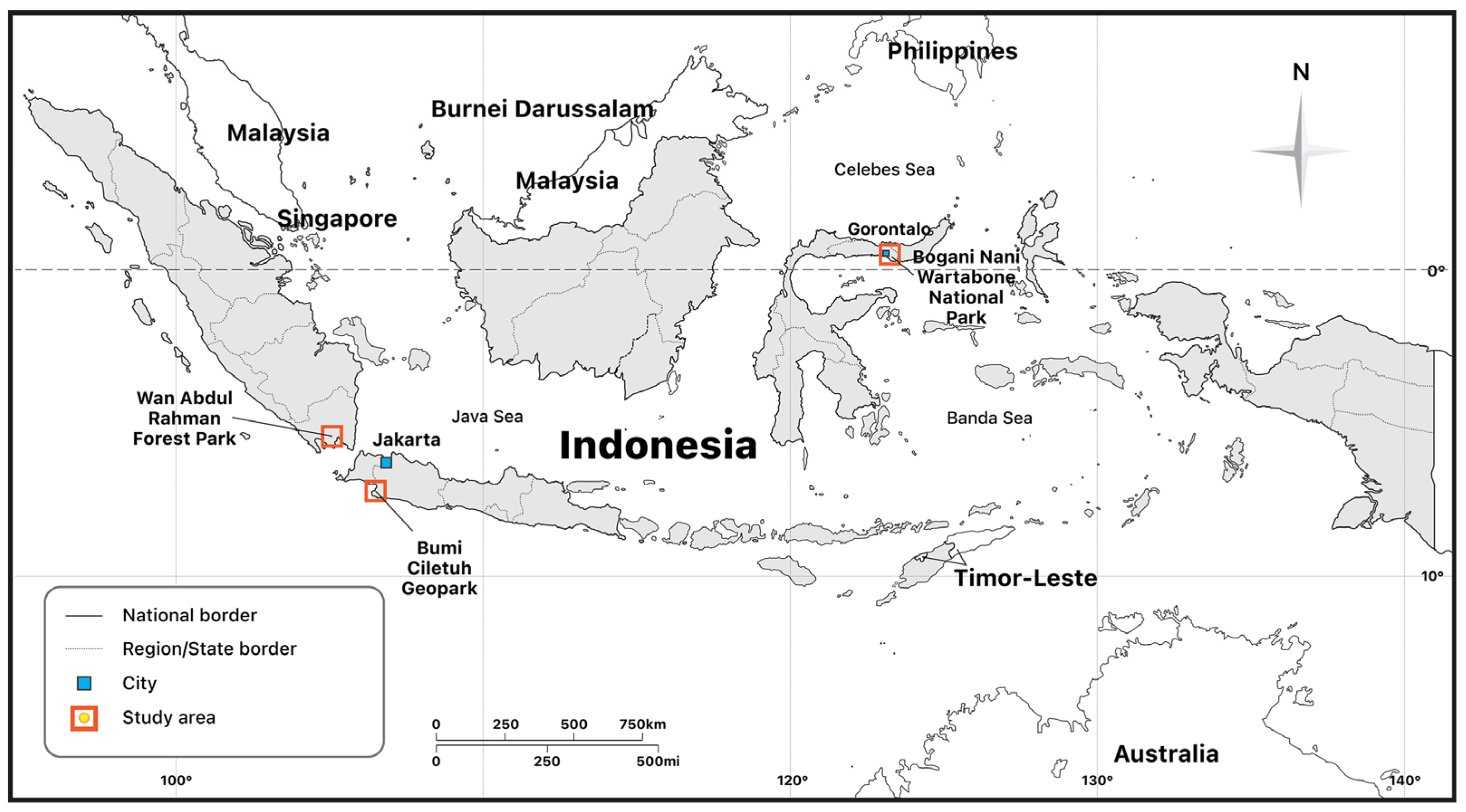
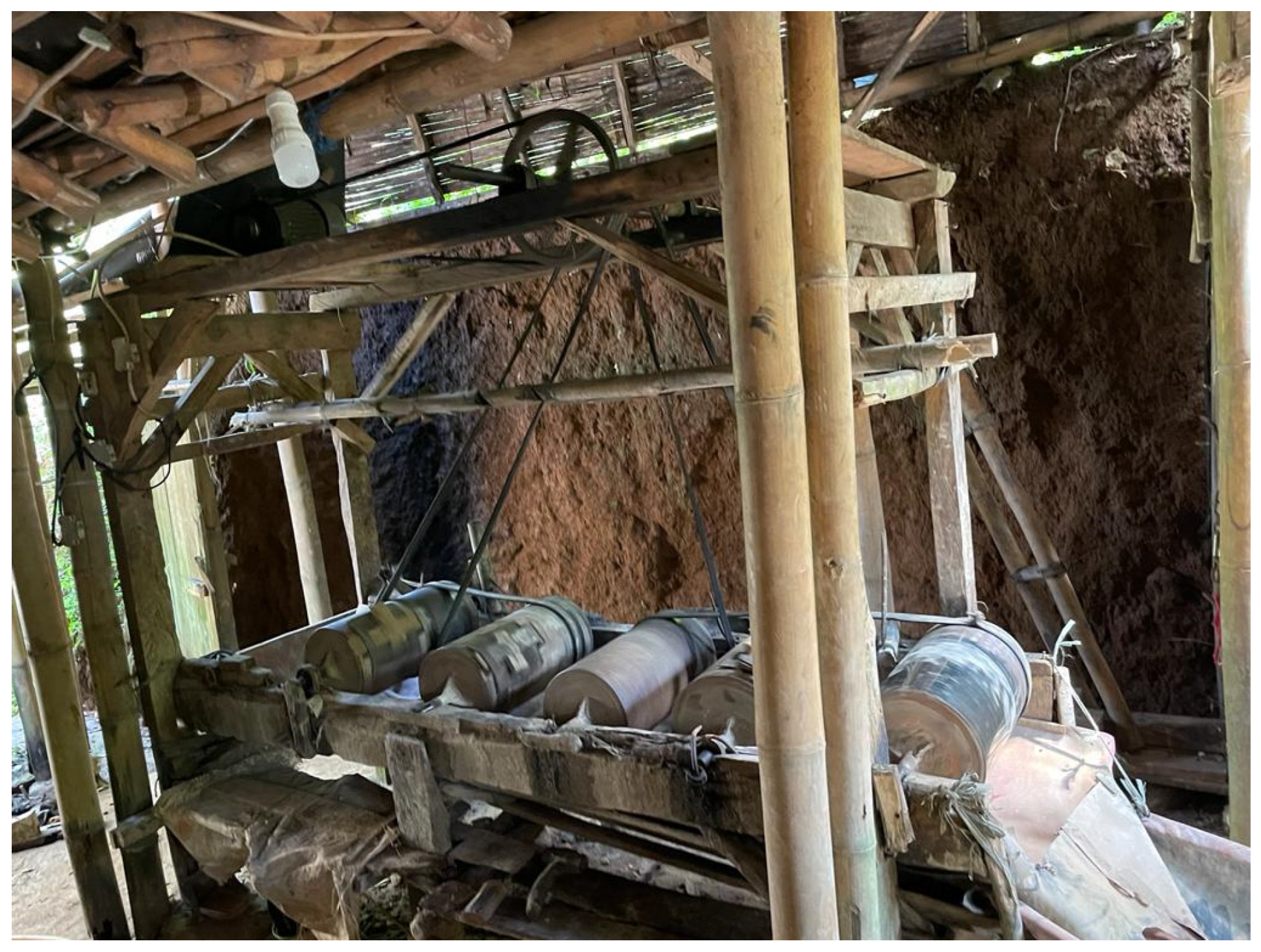
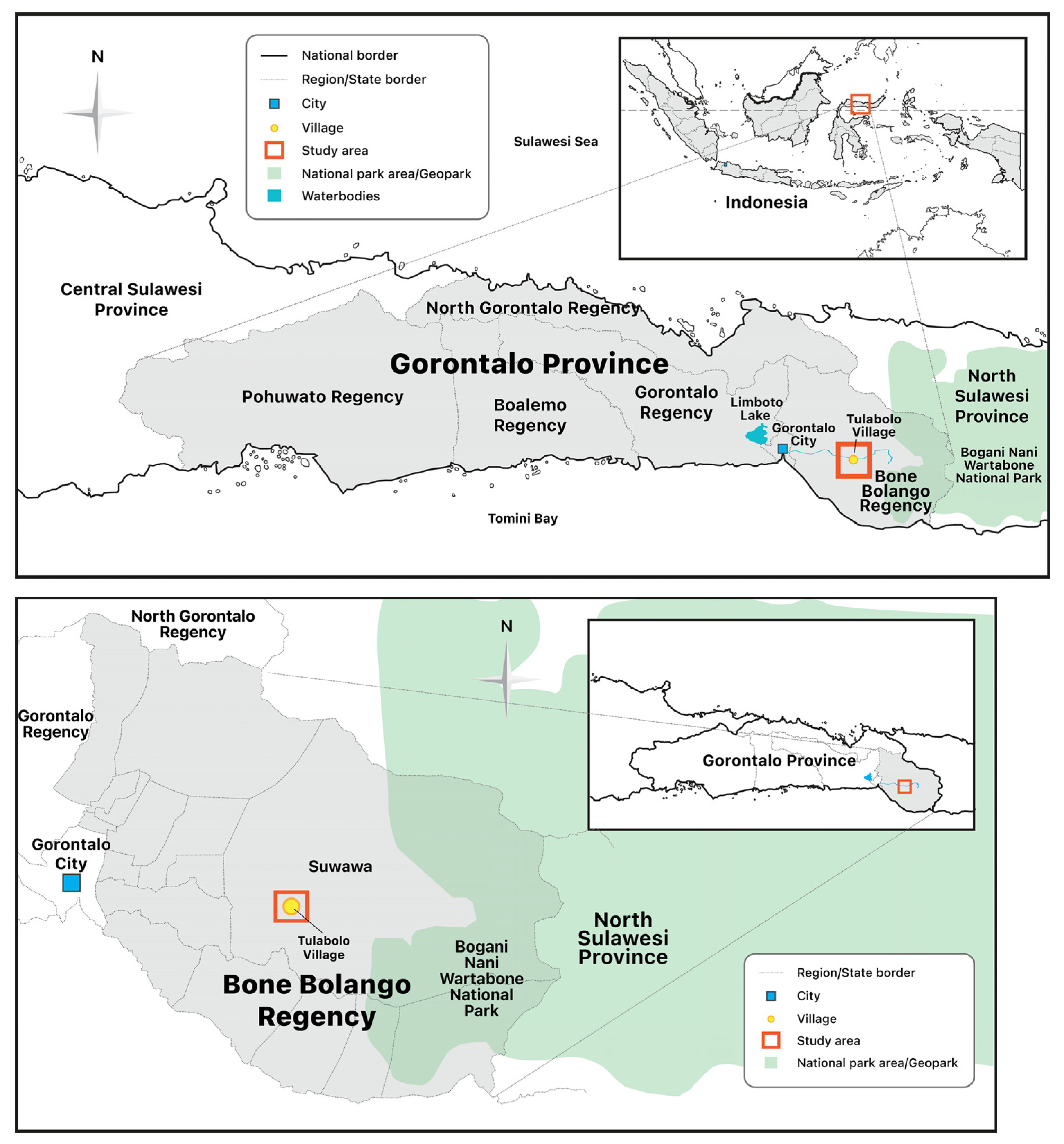
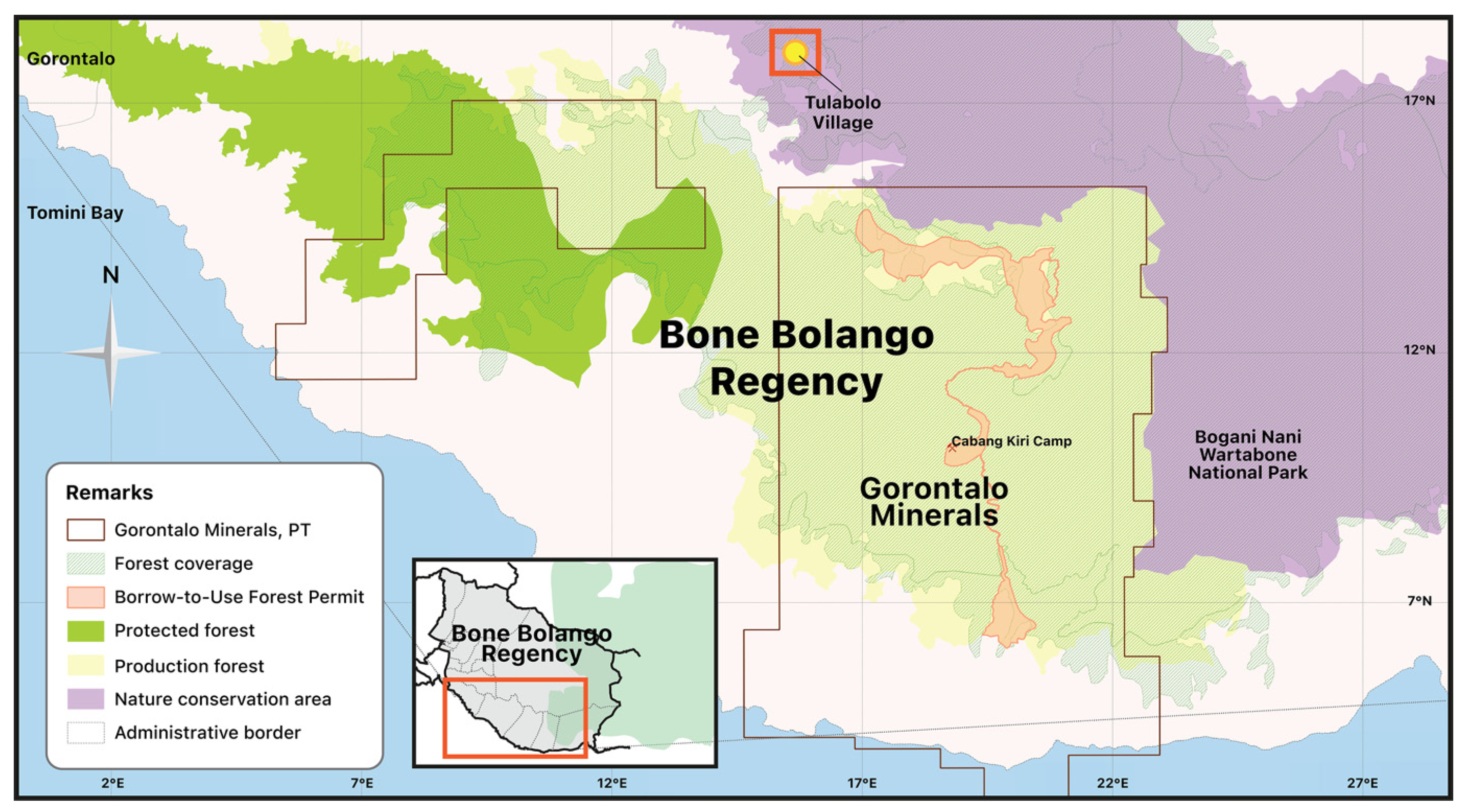

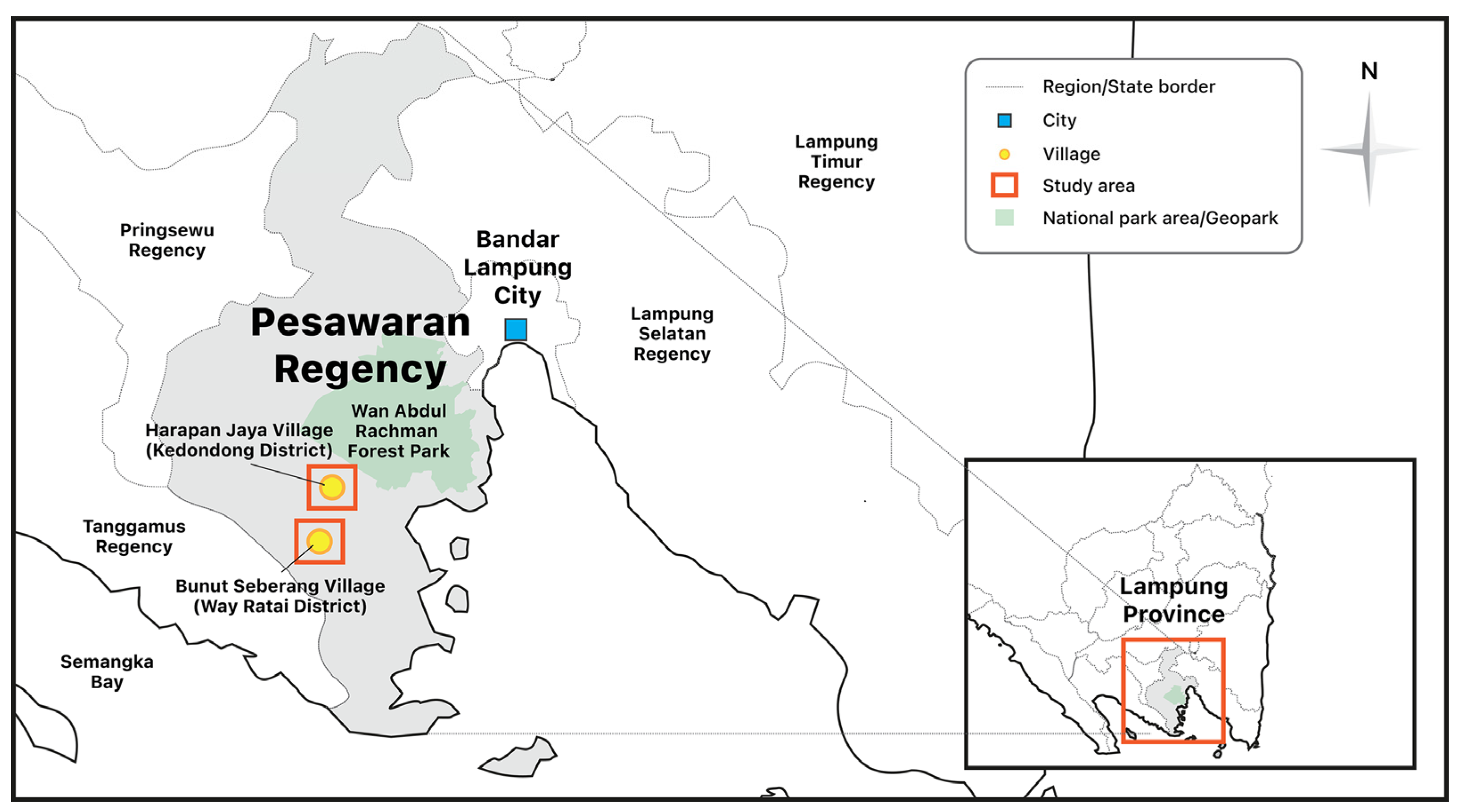
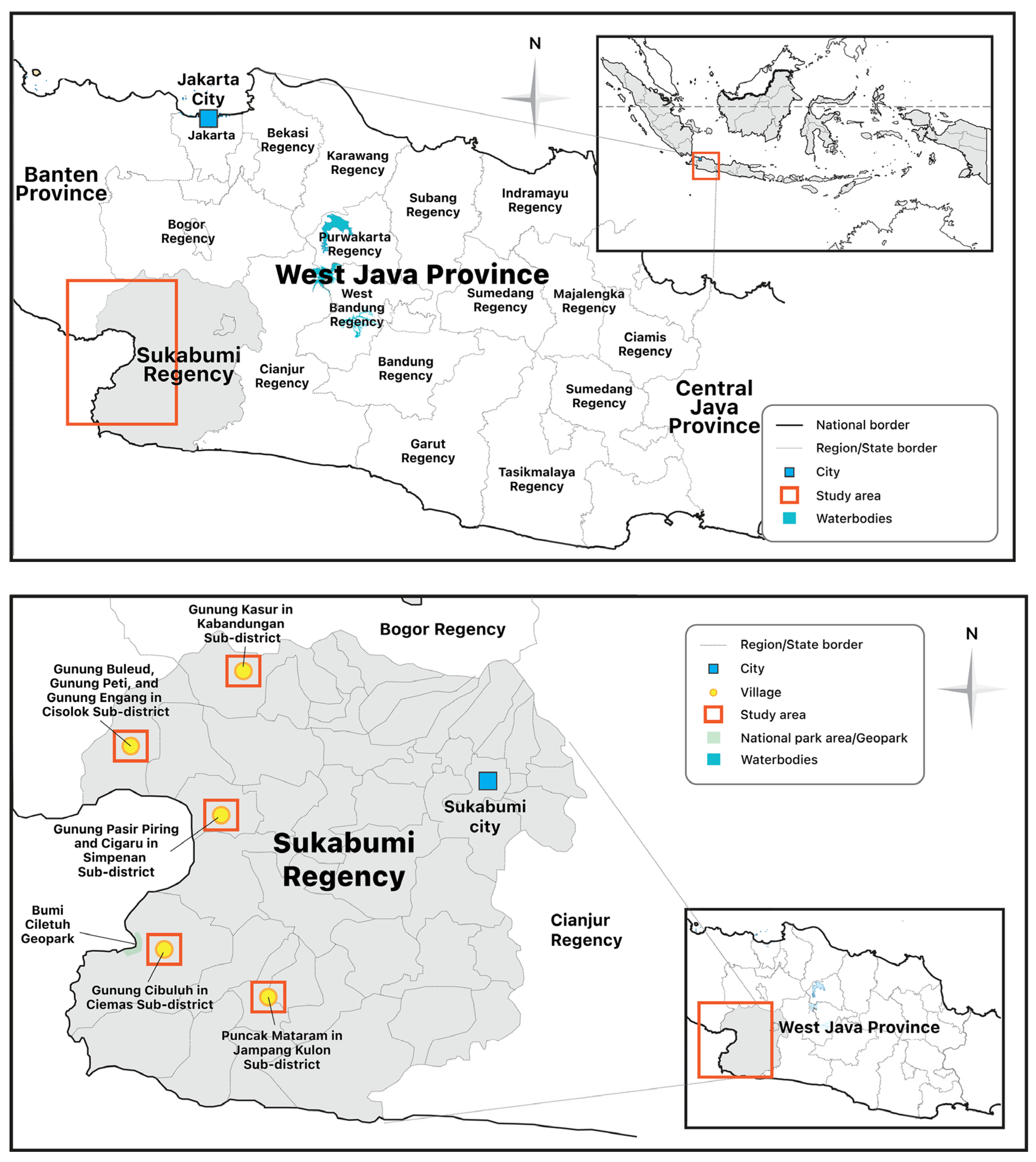

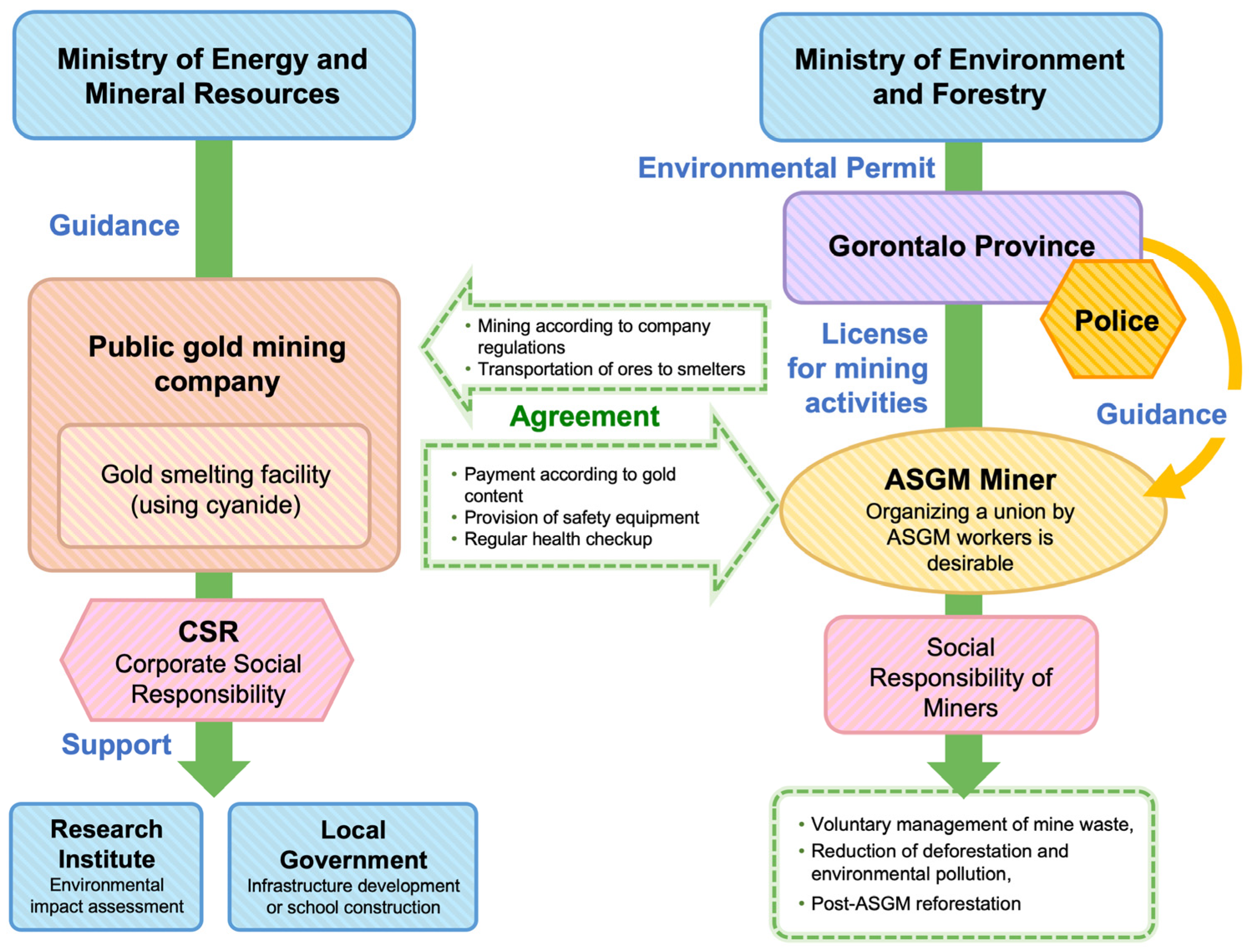
| Location | Description | Conflict | Environmental Effect |
|---|---|---|---|
| Tulabolo Village, Suwawa Timur, Gorontalo Province | Illegal ASGM inside and near National Park Bogani Nani Watobone. Side by side with a large mining company. | Between illegal miners and a large company | Flora and fauna at Bogani Nani Wartabone (intact). Fish in rivers. |
| Pasawanan, Lampung Province | Illegal ASGM side by side with many legal small mining companies. | No conflict; illegal miners support small companies | Forest Park Wan Abdul Rachman. Fish in rivers. |
| Sukabumi, West Java Province | Illegal ASGM joined the association of illegal ASGM miners. Operated within the large-scale plantation and Geopark. | Between the ASGM miners and plantation permit-holders | Bumi Ciletuh Geopark. |
| Affected Environment | Type | Condition |
|---|---|---|
| Forest | Protected forest | deforestation |
| Limited production forest | deforestation | |
| Permanent production forest | deforestation | |
| National Park | Fauna | threatened |
| Flora | threatened | |
| Typical species of Sulawesi | threatened | |
| River | Mak River | turbid |
| Bone River | polluted | |
| Fish | killed | |
| Water | polluted | |
| Land | Land | degraded |
| Water table | decreased |
| Location | Year (Sampling) | Sample Type | Mercury Concentration | Guidelines | Ref. |
|---|---|---|---|---|---|
| Bone Bolango Regency | 2021 | Drinking water, well, and hot spring | 0.02–0.03 µg/L | 6 µg/L WHO | This research |
| Bone Bolango Regency | 2018 | Mining and tailing water | 176–489 µg/L | 6 µg/L WHO and 0.005 mg/L National standard for mining water | [27] (data from the same project team) |
| River water (Bone River) | 16–2080 µg/L | 6 µg/L WHO and 0.002 mg/L (2 µg/L) Indonesian Gov.t Regulation No. 82 year 2001 | |||
| Sediment at mining area Sediment at Bone River | ND–790 µg/g ND–57.9 µg/g | 75 mg/kg PP 101 of 2014 and 0.174 ppm NOAA | |||
| Bone Bolango Regency | 2018 | Soil | 0–36 mg/kg | 0.2 ppb US EPA | [42] (data from the same project team) |
| Plant (Pteris vittate) | 0–5.2 mg/kg | Exceeds 10 ppm: hyperaccumulators of Hg, 1 ppm: toxic and does not exceed 0.5 mg/kg Director General of National Agency of Drug and Food Control No: 03725/B/SK/VII/89 | |||
| Bone Bolango Regency | 2018 | Soil | 32–131 mg/kg | 0.005 mg/L Indonesian Gov. Regulation No. 82 year 2001 and 0.3 mg/kg PP 101 of 2014 | [43] (data from the same project team) |
| Dust (soil) | 15–91 mg/kg | 0.005 mg/L Indonesian Gov. Regulation No. 82 year 2001 and 0.3 mg/kg PP 101 of 2014 | |||
| Bone Bolango Regency | 2022 (2018) | Bone River Sediment | 9.5–86.3 µg/g | 2 mg/kg | [44] (data from the same project team) |
| Bone Bolango Regency | 2018 | Nose (19 samples) and scalp hair (10 samples) | 0.52 ppm–24.4 ppm | 5 ppm high, <1 ppm safe and in between is the warning level | [45] (data from the same project team) |
| Bone Bolango Regency | 2013 | Fish (Decapterus muroadsi, Laligo pealii) | 0.0298 mg/kg (average) 0.01880–0.04103 mg/kg | 0.3 mg/kg National standard and Max 0.5 ppb (0.5 µg/g) WHO | [29] |
| Blood (100 persons) 52 persons above national standard | 2.92–378.90 µg/L | 8 µg/L and <10 µg/L WHO | |||
| Hair (100 persons) 57 persons above national standard | 0.48–260.2 µg/g | 2.0 µg/g National Standard and toxicology threshold limit <1 µg/g normal,1–<5 µg/g alert and >5 µg/g high | |||
| Drinking water | 0.000285–0.00065mg/L | 0.001 mg/L Indonesian Gov. Regulation No. 82 year 2001 |
| Month and Year | Village Name | Affected Environment | Suspected Chemical | Symptom | Affected |
|---|---|---|---|---|---|
| August 2010 | Sinar Harapan (now, Harapan Jaya) | Cikantor River | Cyanide, etc. | vomiting, headache, painful/hot throat, shortness of breath, face very hot, dizziness, and heartburn | 184 people 2 fainted |
| Sinar Harapan (now, Harapan Jaya) | Fishponds | Cyanide | fish killed | 18 ponds | |
| Sinar Harapan (now, Harapan Jaya) | Livestock | Cyanide | livestock killed | some places | |
| March 2019 | Babakan Loa | Cikantor River | Mercury | acute hives | some residents |
| February 2021 | Bunut Seberang | River | Cyanide, etc. | itchy rash | some residents |
| September 2021 | Harapan Jaya | Way Ratai River | feels itchy and fish killed | some residents, huge amount | |
| Way Kepayang | Way Ratai River | feels itchy and fish killed | some residents, huge amount | ||
| February 2023 | Gunung Sugih | River | fish killed | huge amount |
| Location | Year (Sampling) | Sample Type | Mercury Concentration | Guidelines | Ref. |
|---|---|---|---|---|---|
| Sukabumi Regency, West Java (Java Island) | 2019 | Hair (71 persons; 38 men, 33 women) | Men: 0.71–18 ppm Women: 1.5–24 ppm | Toxicology threshold limit: <1 µg/g normal, 1–<5 µg/g alert, >5 µg/g high | [56] |
| Sukabumi Regency, West Java (Java Island) | 2018 | Water | <0.00005 mg/L | 0.002 mg/L PP No. 82 of 2001 | [55] |
| Sediment | 101–196 mg/kg | 75 mg/kg PP 101 of 2014 | |||
| Soil | 0.036–1.8 mg/kg | 0.3 mg/kg PP 101 of 2014 | |||
| Rice (plant) | <0.03–0.14 mg/kg | 0.03 mg/kg SNI 7387:2009 |
Disclaimer/Publisher’s Note: The statements, opinions and data contained in all publications are solely those of the individual author(s) and contributor(s) and not of MDPI and/or the editor(s). MDPI and/or the editor(s) disclaim responsibility for any injury to people or property resulting from any ideas, methods, instructions or products referred to in the content. |
© 2023 by the authors. Licensee MDPI, Basel, Switzerland. This article is an open access article distributed under the terms and conditions of the Creative Commons Attribution (CC BY) license (https://creativecommons.org/licenses/by/4.0/).
Share and Cite
Meutia, A.A.; Bachriadi, D.; Gafur, N.A. Environment Degradation, Health Threats, and Legality at the Artisanal Small-Scale Gold Mining Sites in Indonesia. Int. J. Environ. Res. Public Health 2023, 20, 6774. https://doi.org/10.3390/ijerph20186774
Meutia AA, Bachriadi D, Gafur NA. Environment Degradation, Health Threats, and Legality at the Artisanal Small-Scale Gold Mining Sites in Indonesia. International Journal of Environmental Research and Public Health. 2023; 20(18):6774. https://doi.org/10.3390/ijerph20186774
Chicago/Turabian StyleMeutia, Ami A., Dianto Bachriadi, and Nurfitri Abdul Gafur. 2023. "Environment Degradation, Health Threats, and Legality at the Artisanal Small-Scale Gold Mining Sites in Indonesia" International Journal of Environmental Research and Public Health 20, no. 18: 6774. https://doi.org/10.3390/ijerph20186774
APA StyleMeutia, A. A., Bachriadi, D., & Gafur, N. A. (2023). Environment Degradation, Health Threats, and Legality at the Artisanal Small-Scale Gold Mining Sites in Indonesia. International Journal of Environmental Research and Public Health, 20(18), 6774. https://doi.org/10.3390/ijerph20186774






